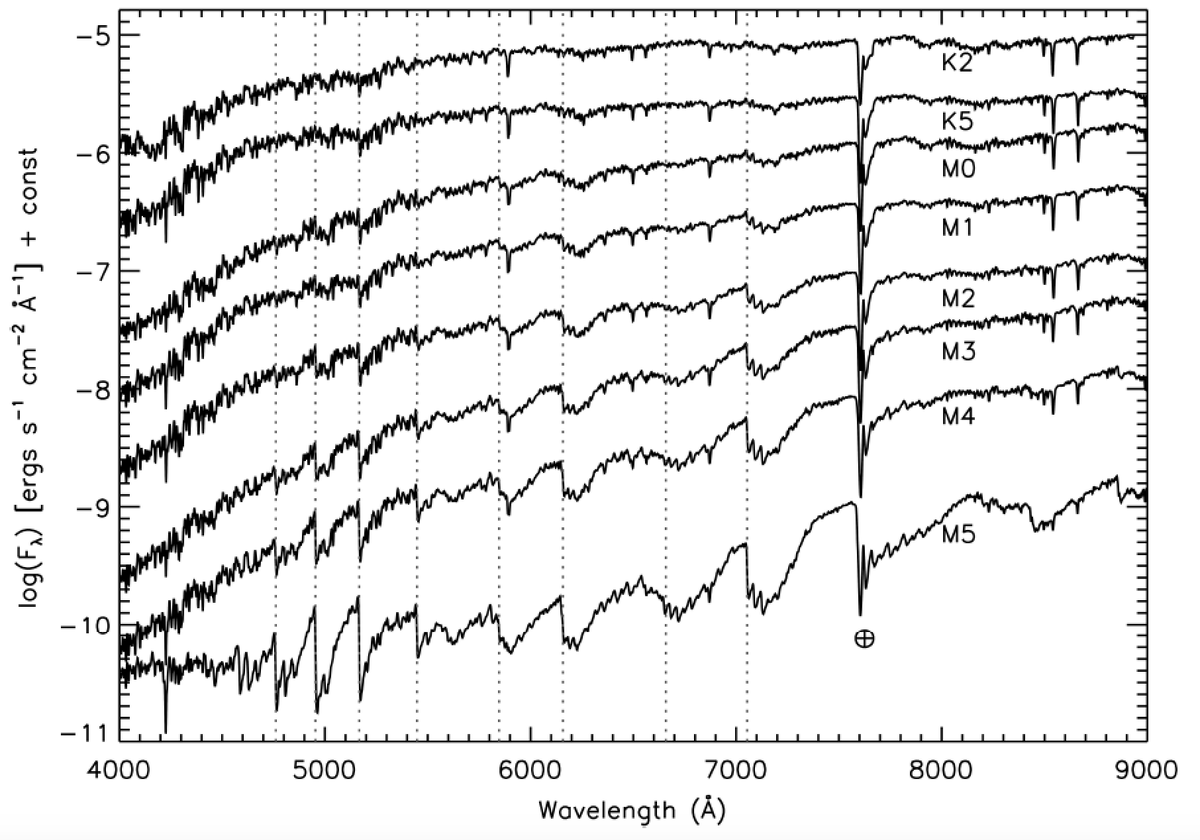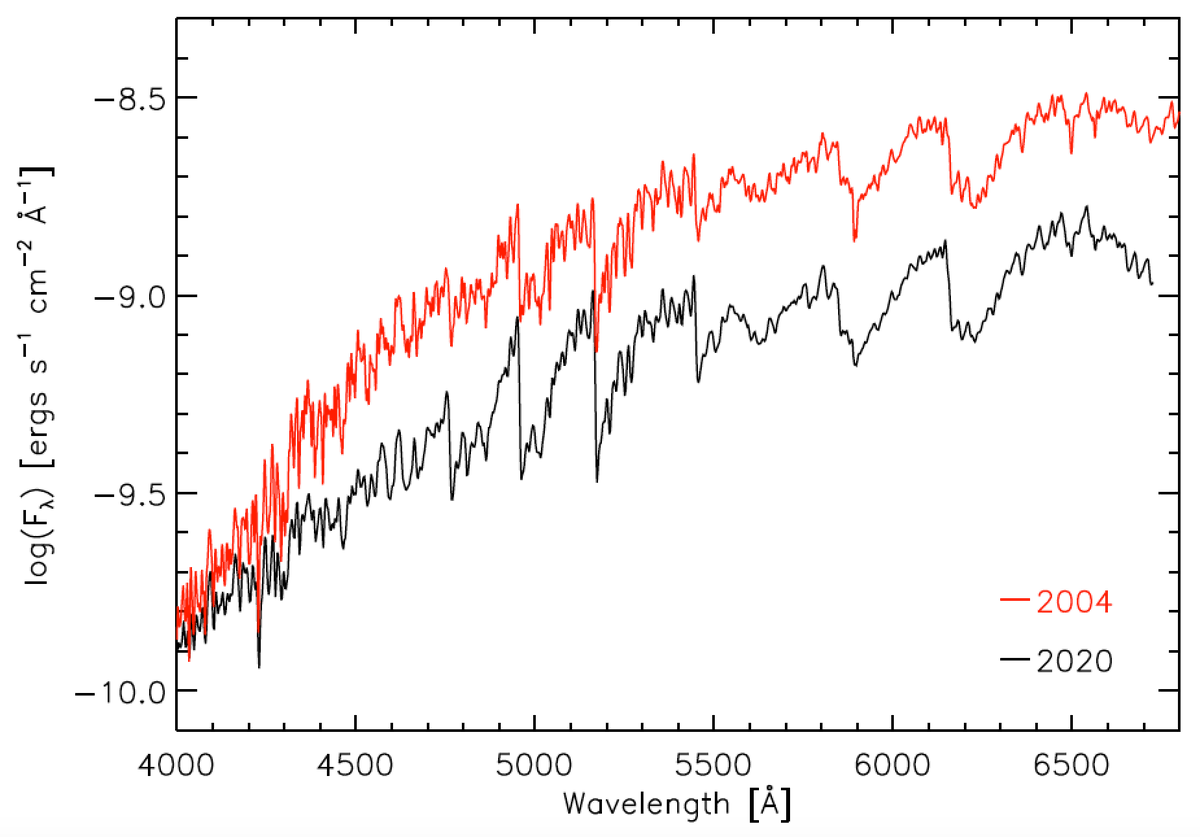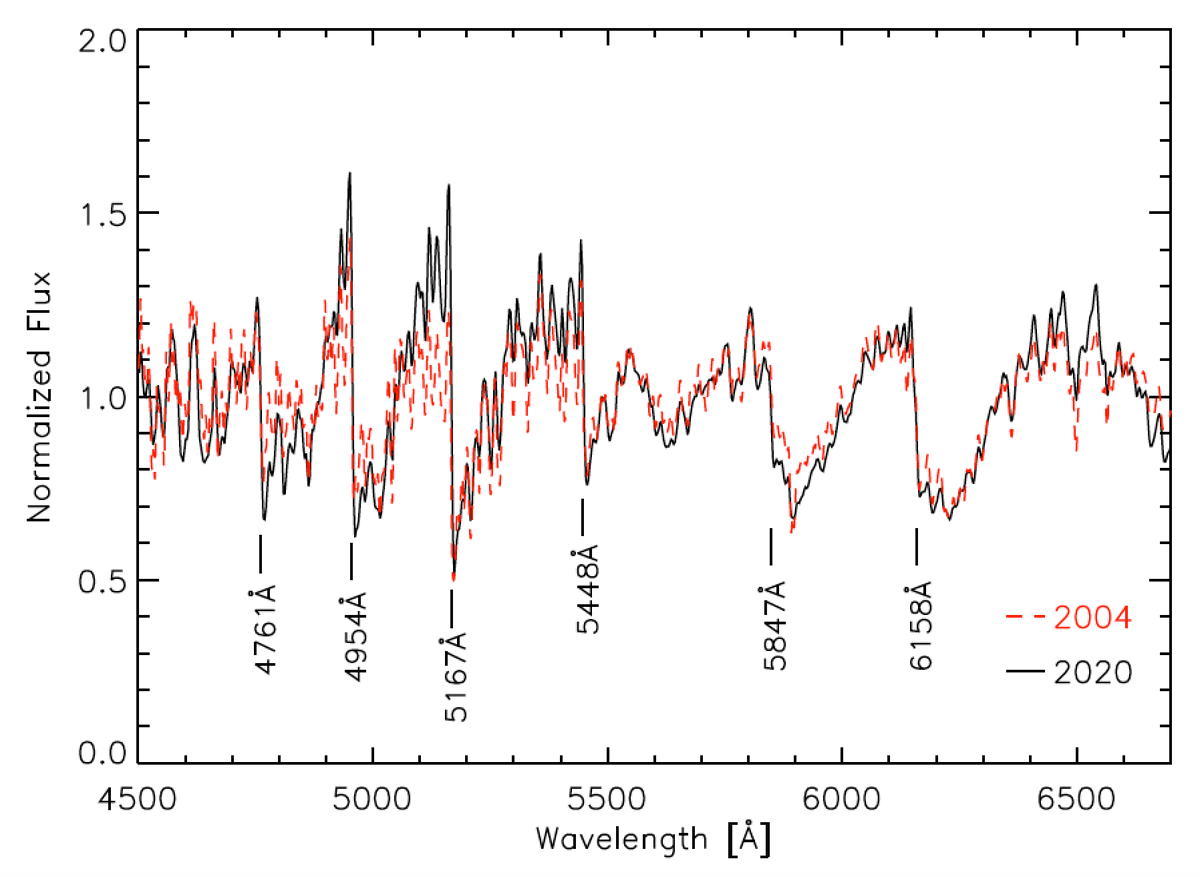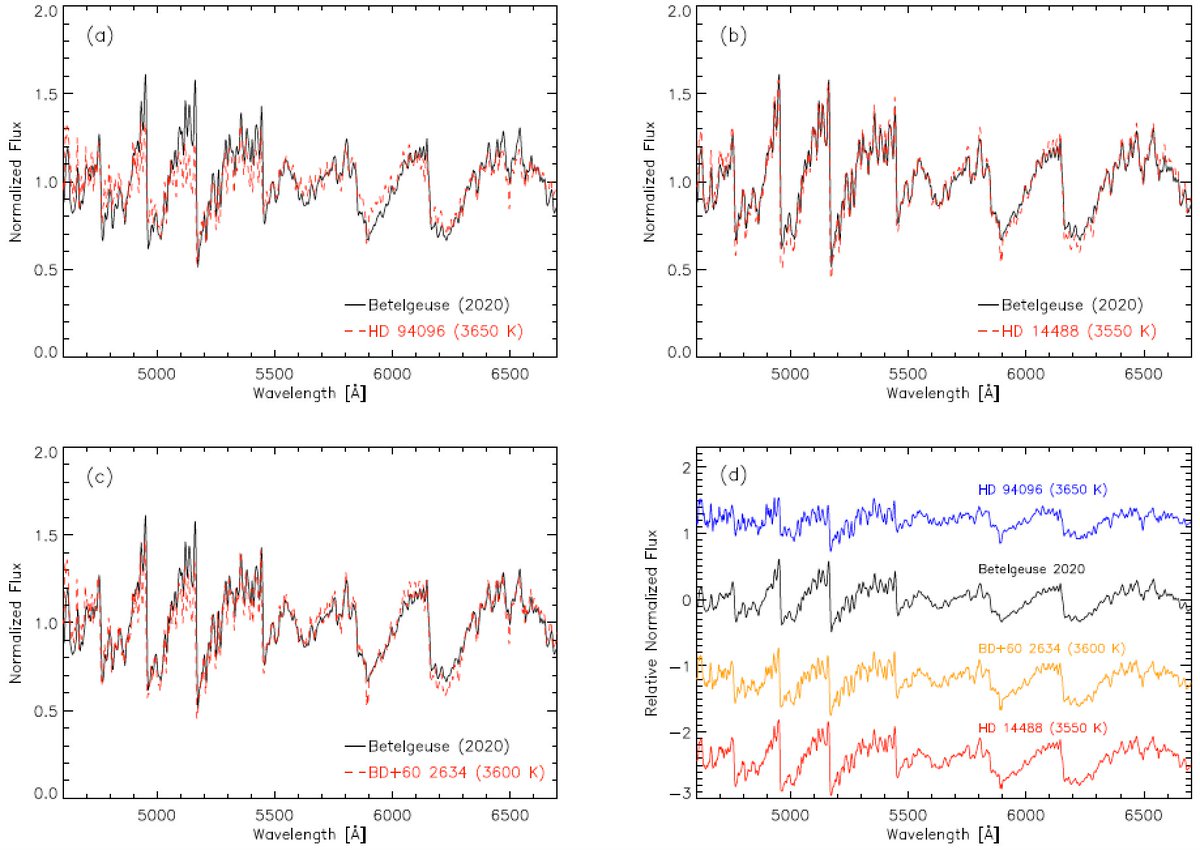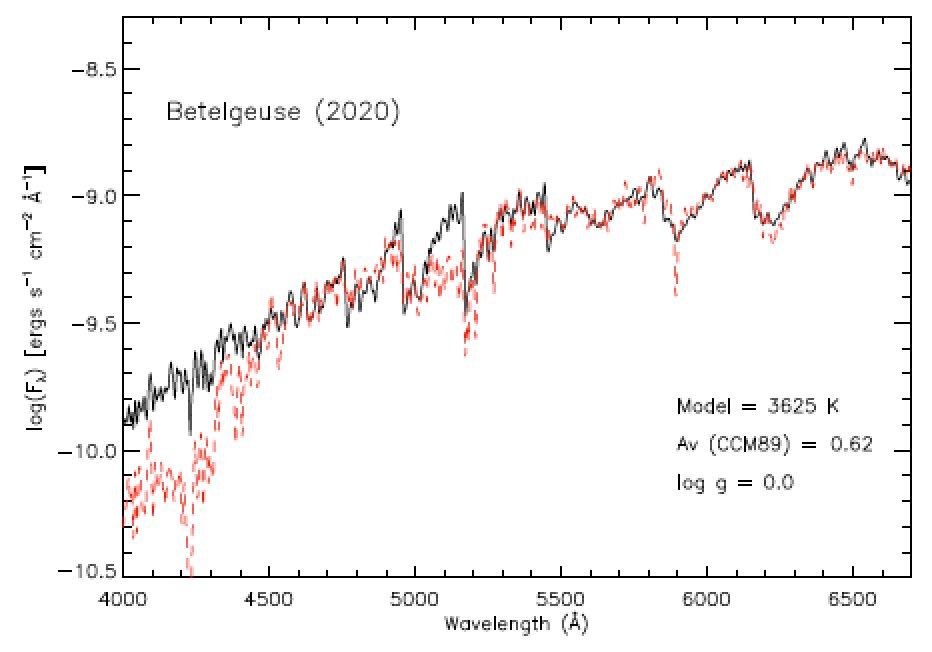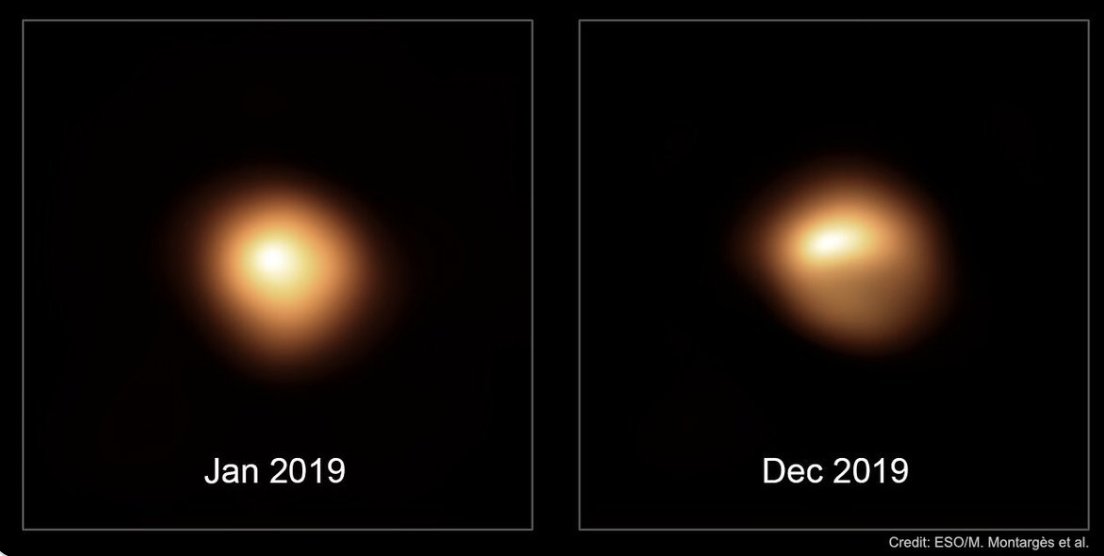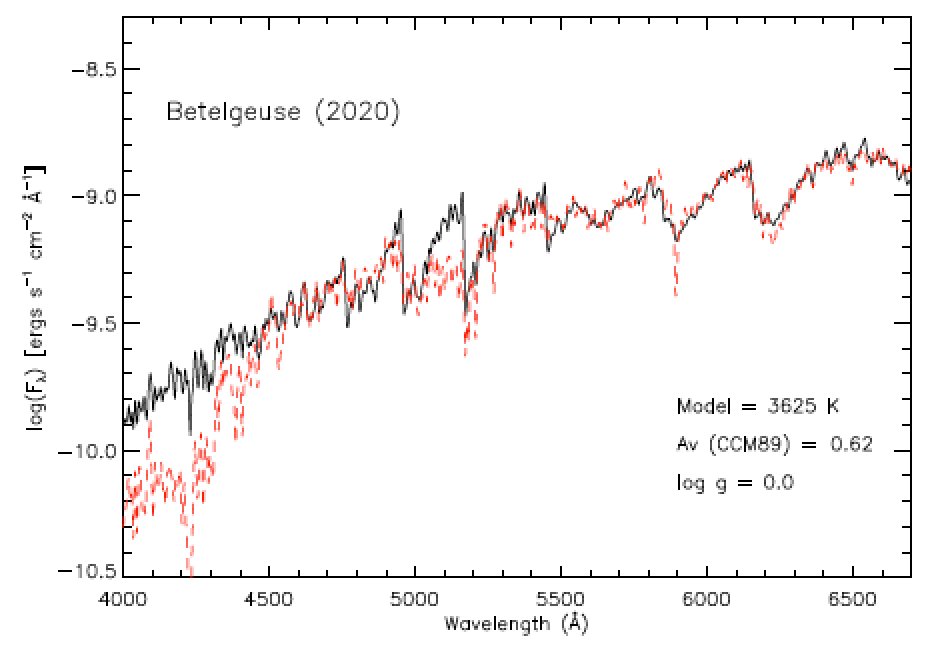So! Last week @MassiveStarGuy and I got some nice data and found out that #Betelgeuse& #39;s recent dimming was NOT caused by a drop in the star& #39;s surface temperature.
A thread!
https://arxiv.org/abs/2002.10463 ">https://arxiv.org/abs/2002....
A thread!
https://arxiv.org/abs/2002.10463 ">https://arxiv.org/abs/2002....
Starting in October, Betelgeuse started dimming pretty impressively, and astronomers started tossing around ideas for what might be causing this sudden drop in the star& #39;s visual brightness. I wrote a thread summarizing the possibilities back in December: https://twitter.com/emsque/status/1209274275586334721">https://twitter.com/emsque/st...
One popular idea was that Betelgeuse looked dimmer because its surface was cooler. Like all red supergiants, Betelgeuse has enormous convective cells that dominate its surface appearance, boiling away and creating what look like big hot and cool spots: https://twitter.com/emsque/status/1209275216112881669">https://twitter.com/emsque/st...
A cooler surface would make Betelgeuse look dimmer because:
1) cooler objects emit less light (and emit it at longer wavelengths as temperature drops)
2) a cooler surface means more titanium oxide (TiO) molecules in the atmosphere; these molecules absorb lots of visible light.
1) cooler objects emit less light (and emit it at longer wavelengths as temperature drops)
2) a cooler surface means more titanium oxide (TiO) molecules in the atmosphere; these molecules absorb lots of visible light.
Point 2 prompted @MassiveStarGuy & I to grab a spectrum of Betelgeuse. TiO bands are GREAT ways to measure temperature since they get stronger as T drops (you can see it in this figure from my book; the TiO bands look like bites taken out of the spectrum, marked w/ dashed lines:)
We decided to get a flux-calibrated spectrum while Betelgeuse was near its minimum brightness, on Feb 15.
We could use the strengths of the TiO bands to estimate its temperature and fit the spectrum with some red supergiant atmosphere models to see if anything looked odd.
We could use the strengths of the TiO bands to estimate its temperature and fit the spectrum with some red supergiant atmosphere models to see if anything looked odd.
The expectation was that if big cool convection cells were behind Betelgeuse& #39;s sudden drop in brightness, the TiO bands would CLEARLY be WAY stronger and the whole spectrum would look noticeably redder.
That night @MassiveStarGuy got a gorgeous spectrum with the @LowellObs Lowell Discovery Telescope (thanks to a very hefty neutral density filter). We compared our spectrum of newly-dim Betelgeuse (black) with an old spectrum we& #39;d gotten of "normal" Betelgeuse in 2004 (red).
Um:
Um:
The spectra look almost identical! In 2004 Betelgeuse was 3650 K; in 2020 it didn& #39;t really seem much colder! Still, we wanted to do a careful comparison.
Here& #39;s a zoomed-in look of the 2004 and 2020 spectra.
The TiO bands are a LITTLE deeper in the 2020 spectrum, but not much:
Here& #39;s a zoomed-in look of the 2004 and 2020 spectra.
The TiO bands are a LITTLE deeper in the 2020 spectrum, but not much:
We tried comparing Betelgeuse to some other Milky Way red supergiants as well.
In the end, Betelgeuse looked the most like a 3600 K red supergiant; the TiO bands were a little deeper than in a 3650 K star, but not as deep as a 3550 K star:
In the end, Betelgeuse looked the most like a 3600 K red supergiant; the TiO bands were a little deeper than in a 3650 K star, but not as deep as a 3550 K star:
What about theoretical models? Our best-fit model (red) gave us a T of 3625 K w/ a +/- 25 K error. The models also tend to slightly under-predict a couple of those bluer TiO bands.
Combining this with our star comparisons, we settled on a Feb 15 2020 T=3600 K for Betelgeuse.
Combining this with our star comparisons, we settled on a Feb 15 2020 T=3600 K for Betelgeuse.
So, during its dimming episode Betelgeuse had only gotten ~50 K colder. But hey: maybe that& #39;s enough to explain the drop in brightness?
Nope. After doing the math, it turns out a 50K decrease would make Betelgeuse about 0.4 mag dimmer. It had gotten 1.1 MAG DIMMER since October!
Nope. After doing the math, it turns out a 50K decrease would make Betelgeuse about 0.4 mag dimmer. It had gotten 1.1 MAG DIMMER since October!
Based on our data it seems pretty certain that temperature can& #39;t explain Betelgeuse& #39;s recent dimming episode. So what can?
Dust.
Dust.
Red supergiants are known for sporadically and asymmetrically producing dust thanks to their weird mass loss behavior. That dust is also known to be a bit unusual.
Little "normal" interstellar dust grains makes objects appear redder (it scatters blue light but lets red light through).
RSG-produced dust grains tend to be bigger, which means they act "gray" - they absorb red AND blue light and wind up making objects look dimmer.
RSG-produced dust grains tend to be bigger, which means they act "gray" - they absorb red AND blue light and wind up making objects look dimmer.
Some gorgeous images of Betelgeuse from @ESO and @Astro_MiguelM did indeed show the southern hemisphere of Betelgeuse looking much dimmer in Dec 2019 as compared to Jan 2019.
We think this could be happening because there& #39;s some new large-grain dust blocking our view down there.
We think this could be happening because there& #39;s some new large-grain dust blocking our view down there.
"Big dust" also agrees w/ our 2020 data: we didn& #39;t see any more "normal" dust around Betelgeuse, but we did see some excess light over in the blue when comparing real data to model data. That excess wasn& #39;t there in 2004, but @MassiveStarGuy and I had seen this effect elsewhere...
Back in 2005 we found other red supergiants that looked like this, and concluded that the blue excess was coming from dust reflection nebulae around stars that had lots of this gray circumstellar dust. It looks like Betelgeuse is now in the same boat!
https://arxiv.org/abs/astro-ph/0508254">https://arxiv.org/abs/astro...
https://arxiv.org/abs/astro-ph/0508254">https://arxiv.org/abs/astro...
Still: there& #39;s a LOT left for us to explore. It& #39;d be great to see direct observations of Betelgeuse& #39;s dust and circumstellar environment to test out our theory! It& #39;d also be cool to learn more about the composition, size, mass, and distribution of the dust grains around the star.
AND: it looks like Betelgeuse is now brightening again! It& #39;s hard to predict timing for how dust should affect Betelgeuse& #39;s brightness (we& #39;d need to know what I listed above: size, composition, mass, distribution), but we should keep monitoring it to see what else we can learn.
In summary: #Betelgeuse Just Isn& #39;t That Cool.
However, it IS still an awesome and fascinating star, and we should all keep studying it!
However, it IS still an awesome and fascinating star, and we should all keep studying it!

 Read on Twitter
Read on Twitter